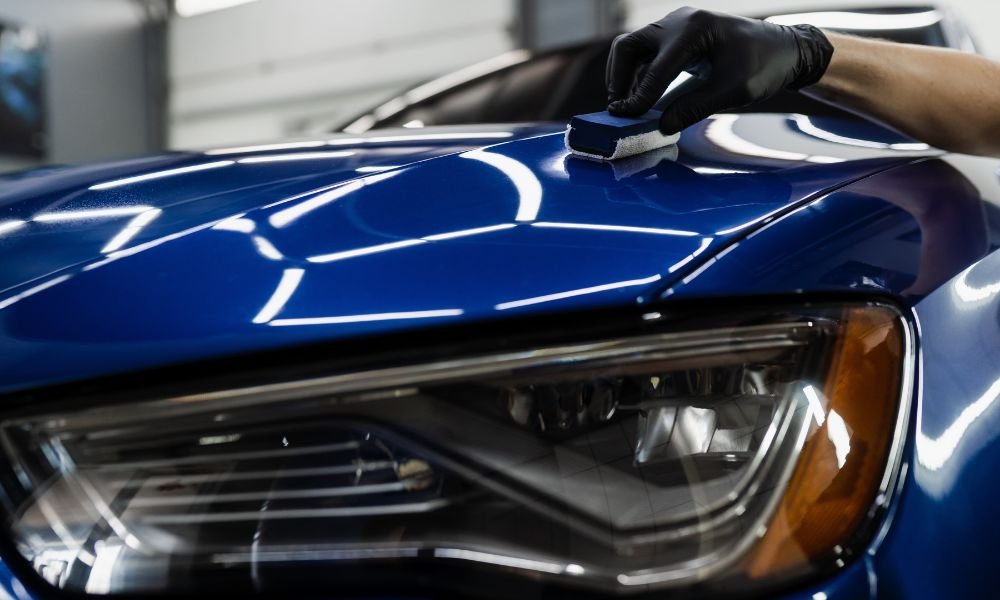Why Ceramic Covering Is the Ultimate Solution for a Perfect Finish
Ceramic covering has arised as a leading service for those looking for a flawless finish for their automobiles, thanks to its amazing sturdiness and safety features. What aspects absolutely set ceramic covering apart?
What Is Ceramic Layer?

When applied correctly, ceramic finish produces a hydrophobic surface that pushes back water and dirt, making it much easier to cleanse and maintain. Unlike traditional waxes or sealants, which usually provide temporary security, ceramic finishes can last for numerous years, depending upon the product top quality and application method. The process of applying ceramic finish calls for careful preparation, consisting of extensive cleaning and often paint modification, to guarantee ideal bonding and performance.
Ceramic finishes are not restricted to automobile surface areas; they can additionally be used on different products, consisting of glass, metal, and plastics, supplying a versatile option for enhancing protection. Overall, ceramic finish stands for a considerable improvement in surface protection technology, combining both practical and aesthetic benefits for a broad variety of applications.
Benefits of Ceramic Coating
While numerous surface area protection options exist, the benefits of ceramic coating stick out because of its special properties and long-lasting performance. One of the primary advantages is its remarkable longevity. Ceramic Coating Philadelphia. Unlike typical wax or sealers that require constant reapplication, ceramic finishings offer a resistant layer that can last for a number of years, dramatically reducing maintenance efforts
Another remarkable benefit is improved protection against ecological contaminants. Ceramic layers create a hydrophobic surface that drives away water, dirt, and various contaminants, making it less complicated to clean. This function not only maintains the vehicle's appearance however likewise minimizes the threat of rust and oxidation, particularly in harsh climate condition.
Additionally, ceramic finishes supply exceptional resistance to UV rays, stopping fading and destruction of paint gradually. This UV protection is important for preserving the visual value of surface areas and automobiles subjected to direct sunshine.
Furthermore, the shiny coating accomplished with ceramic layer improves the overall visual charm, providing surfaces a showroom-quality luster. Overall, ceramic finishings represent a substantial improvement in surface area protection technology, supplying enduring advantages that satisfy both practical and visual needs.
How It Works
Recognizing the scientific research behind ceramic coatings exposes exactly how they supply such exceptional protection and longevity. At its core, a ceramic finishing is a liquid polymer that chemically bonds with the automobile's manufacturing facility paint.
The application process entails numerous actions, consisting of surface area preparation, which is critical to attaining optimal adhesion. When applied, the coating undergoes a curing process, during which it hardens and develops a semi-permanent bond with the paint surface. This bond is what distinguishes ceramic finishings from typical waxes and sealants, giving a longer-lasting protective obstacle that can sustain for many years.
In addition, the Read More Here density of the finish can improve its protective high qualities, ensuring that it can endure severe conditions. Inevitably, the science of ceramic finishes integrates innovative materials with ingenious application techniques to deliver an exceptional degree of protection and aesthetic enhancement for automobiles.
Contrast With Traditional Techniques
The advantages of ceramic coatings become especially evident when contrasted to typical paint protection techniques such as sealers and waxes. While waxes provide a momentary luster, normally lasting a couple of weeks to a pair of months, ceramic layers offer a lasting protective layer that can withstand for several years. This longevity significantly reduces the regularity of reapplication, making ceramic finishes an extra economical remedy with time.
In addition, conventional techniques usually need considerable prep work and multiple applications to accomplish an acceptable level of defense. In comparison, ceramic coatings bond at a molecular degree with the vehicle's surface area, developing a durable guard against ecological pollutants like UV rays, acid rain, and roadway salts. This bond boosts the automobile's resistance to scratches and swirl marks, which prevail with conventional waxes and sealers.
In addition, the hydrophobic residential properties of ceramic finishes drive away water and dirt, leading to easier cleansing and maintenance. In contrast, wax and sealant-treated surface areas can bring in gunk, necessitating even more regular washing - Ceramic Coating Philadelphia. Overall, ceramic finishings not just give superior security however additionally deliver an extra aesthetically appealing and long-lasting coating, establishing them as the preferred option for critical lorry owners
Application and Maintenance Tips

Utilizing a foam applicator, use the coating in tiny sections, adhering to the supplier's guidelines relating to density and overlap. Enable enough treating time in between layers, usually 24 hr, to make sure proper bonding. After application, it is important to prevent direct exposure to water or harsh components for a minimum of a week to enable the finish to totally treat.
For maintenance, clean the vehicle consistently with pH-balanced soaps and prevent abrasive products. Touchless vehicle cleans are recommended to lessen damaging. Furthermore, utilizing a ceramic upkeep spray can enhance the finishing's hydrophobic properties and durability. Routine examinations for any type of signs of wear will certainly help preserve the coating's integrity and maintain that beautiful finish.
Conclusion
Finally, ceramic coating becomes a remarkable choice for attaining a remarkable automotive coating. Its outstanding longevity, safety high qualities, and hydrophobic homes significantly enhance the vehicle's look while streamlining more upkeep efforts. By developing a robust bond with manufacturing facility paint, ceramic coating effectively shields against scratches, UV rays, and environmental contaminants. With a lifespan expanding numerous years, this innovative remedy not just preserves however also elevates the total visual charm of lorries, making it an affordable investment for automobile lovers.
